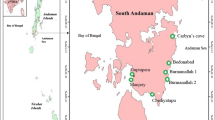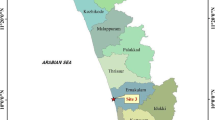Abstract
Mangrove ecosystems are highly productive and play an important role in tropical and global coastal carbon (C) budgets. However, soil organic carbon (SOC) storage and turnover in mangrove forests are still poorly understood. Based on C and C isotopic measurements of soil cores from two natural mangrove forests in Southern China, SOC density was 674.41 Mg ha−1 in one forest (site 1, a Aegiceras corniculatum-dominated high tidal flat) and 372.83 Mg ha−1 in the other forest (site 2, a Bruguiera gymnorrhiza + Kandelia candel-dominated middle tidal flat). SOC storage in the upper 100 cm in mangrove forests in China was estimated to be 13.65–24.68 Tg. SOC δ13X values in the two mangrove forests ranged from − 29.36 to − 25.90 ‰. SOC δ13C was enriched with depth at 20–70 cm at site 1 (which is similar to the trend in most terrestrial ecosystems) but not at site 2, probably because the latter but not the former forest experienced frequent tidal flushing of the surface soil. SOC δ13C enrichment with depth at site 1 was not due to depletion of δ13C of atmospheric CO2 by fossil fuel emissions or to the difference between root and leaf 13C, but possibly resulted from preferential microbial decomposition; this inference was supported by the Rayleigh distillation model, which also indicated that C was mainly from the parent A. corniculatum forest. C and stable C isotopic measurements indicated that tidal fluctuation greatly impacted SOC deposition in these mangrove forests; the high tidal flat (site 1) and the middle tidal flat (site 2) showed terrestrial and oceanic deposition characteristics, respectively. 14C from the testing of thermonuclear weapons had penetrated to 50–60 cm in the two forests. SOC turnover time varied with depth. The surface SOC turnover time at both sites was about 0.5 year, because most surface SOC consisted of easily decomposed litter. SOC turnover time at 20–60 cm at site 1 and at 25–50 cm at site 2 was 4.44–26.04 year. Abundant roots apparently accounted for the short SOC turnover times at these middle soil layers.
Access this chapter
Tax calculation will be finalised at checkout
Purchases are for personal use only
Similar content being viewed by others
References
Adeel Z, Pomeroy R (2002) Assessment and management of mangrove ecosystems in developing countries. Trees 16:235–238
Agren GI, Bosatta E, Balesdent J (1996) Isotope discrimination during decomposition of organic matter: a theoretical analysis. Soil Sci Society Amer J 60:1121–1126
Balesdent J, Mariotti A (1996) Measurement of soil organic matter turnover using 13C natural abundance. In: Boutton TW, Yamasaki S (eds) Mass spectrometry of soils. Marcel Dekker, New York, pp 83–111
Balesdent J, Girardin C, Mariotti A (1993) Site related delta 13C of tree leaves and soil organic matter in a temperate forest. Ecology 74:1713–1721
Bol RA, Harkness DD, Huang Y, Howard DM (1999) The influence of soil processes on carbon isotope distribution and turnover in the British uplands. Euro J Soil Sci 50:41–51
Bouillon S, Bottcher ME (2006) Stable isotopes in biogeosciences—preface. Org Geochem 37:1197–1199
Bouillon S, Dahdouh-Guebas F, Rao A, Koedam N, Dehairs F (2003) Sources of organic carbon in mangrove sediments: variability and possible ecological implications. Hydrobiologia 495:33–39
Bouillon S, Connolly RM, Lee SY (2008) Organic matter exchange and cycling in mangrove ecosystems: recent insights from stable isotope studies. J Sea Res 59:44–58
Boutton TW (1996) Stable carbon isotope ratios of soil organic matter and their use as indicators of vegetation and climate change. In: Boutton TW, Yamasaki S (eds) Mass spectrometry of soil. Marcel Dekker, New York, pp 311–339
Briggs SV (1977) Estimates of biomass in a temperate mangrove community. Aus J Ecol 2:369–373
Chen QQ, Sun YM, Shen CD, Peng SL, Yi WX, Li Z, Jiang MT (2002) Organic matter turnover rates and CO2 flux from organic matter decomposition of mountain soil profiles in the subtropical area. Catena 49:217–229
Chen QQ, Gu HQ, Zhou JZ, Meng Y, Hu KL (2007) Trends of soil organic matter turnover in the salt marsh of the Yangtze River estuary. J Geograph Sci 10:101–113
Cherkinsky AE, Brovkin VA (1993) Dynamics of radiocarbon in soils. Radiocarbon 35:363–367
Chmura GL, Anisfeld SC, Cahoon DR, Lynch JC (2003) Global carbon sequestration in tidal, saline wetland soils. Global Biogeochem Cy 17:1–22
Choi YH, Wang Y (2004) Dynamics of carbon sequestration in a coastal wetland using radiocarbon measurements. Global Biogeochem Cy 18:1–12
Ehleringer JR, Buchmann N, Flanagan LB (2000) Carbon isotope ratios in belowground carbon cycle processes. Ecol Appl 10:412–422
Fontaine S, Barot S, Barre P, Bdioui N, Mary B, Rumpel C (2007) Stability of organic carbon in deep soil layers controlled by fresh carbon supply. Nature 450:277–288
Fujimoto K, Imaya A, Tabuchi R, Kuramoto S, Utsugi H, Murofushi T (1999) Belowground carbon storage of Micronesian mangrove forests. Ecol Res 14:409–413
Gleason SM, Ewel KC (2002) Organic matter dynamics on the forest floor of a Micronesian mangrove forest: an investigation of species composition shifts. Biotropica 34:190–198
Gonneea ME, Paytan A, Herrera-Silveira JA (2004) Tracing organic matter sources and carbon burial in mangrove sediments over the past 160 years. Estuar Coastal Shelf Sci 61:211–227
He BY, Lai TH, Fan HQ, Wang WQ, Zheng HL (2007) Comparison of flooding-tolerance in four mangrove species in a diurnal tidal zone in the Beibu Gulf. Estuar Coastal Shelf Sci 74:254–262
Hua Q, Barbetti M (2004) Review of tropospheric bomb C-14 data for carbon cycle modeling and age calibration purposes. Radiocarbon 46:1273–1298
Jennerjahn TC, Ittekkot V (2002) Relevance of mangroves for the production and deposition of organic matter along tropical continental margins. Naturwissenschaften 89:23–30
Khan MNI, Suwa R, Hagihara A (2007) Carbon and nitrogen pools in a mangrove stand of Kandelia obovata (S., L.) Yong: vertical distribution in the soil-vegetation system. Wetlands Ecol Manag 15:141–153
Komiyama A, Ogino K, Aksornkoae S, Sabhasri S (1987) Root biomass of a mangrove forest in southern Thailand. 1. Estimation by the trench method and the zonal structure of root biomass. J Trop Ecol 3:97–108
Kristensen E, Bouillon S, Dittmar T, Marchand C (2008) Organic carbon dynamics in mangrove ecosystems: a review. Aquat Bot 89:201–219
Levin I, Kromer B (2004) The tropospheric (CO2)-C-14 level in mid-latitudes of the Northern Hemisphere (1959–2003). Radiocarbon 46:1261–1272
Levin I, Hammer S, Kromer B, Meinhardt F (2008) Radiocarbon observations in atmospheric CO2: determining fossil fuel CO2 over Europe using Jungfraujoch observations as background. Sci Total Env 391:211–216
Machiwa JF (2000) C-13 signatures of flora, macrofauna and sediment of a mangrove forest partly affected by sewage waste. Tanzan J Sci 26:15–28
Matsui N (1998) Estimated stocks of organic carbon in mangrove roots and sediments in Hinchinbrook Channel, Australia. Mangroves Salt Marshes 2:199–204
Middleton BA, McKee KL (2001) Degradation of mangrove tissues and implications for peat formation in Belizean island forests. J Ecol 89:818–828
Muzuka ANN, Shunula JP (2006) Stable isotope compositions of organic carbon and nitrogen of two mangrove stands along the Tanzanian coastal zone. Estuar Coastal Shelf Sci 66:447–458
Powers JS, Schlesinger WH (2002) Geographic and vertical patterns of stable carbon isotopes in tropical rain forest soils of Costa Rica. Geoderma 109:141–160
Rayleigh JW (1896) Theoretical considerations respecting the separation of gases by diffusion and similar processes. The London, Edinburgh, and Dublin Philosophical Magazin 42:493–498
Ren H, Jian SG, Lu HF, Zhang QM, Shen WJ, Han WD, Yin ZY, Guo QF (2008) Restoration of mangrove plantations and colonisation by native species in Leizhou bay, South China. Ecol Res 23:401–407
Santruckova H, Bird MI, Lloyd J (2000) Microbial processes and carbon-isotope fractionation in tropical and temperate grassland soils. Func Ecol 14:108–114
Schweizer M, Fear J, Cadisch G (1999) Isotopic (C-13) fractionation during plant residue decomposition and its implications for soil organic matter studies. Rapid Commu Mass Spectro 13:1284–1290
Spalding MD, Blasco F, Field CD (1997) World mangrove atlas. International society for mangrove ecosystems, Okinawa, Japan, P 178
Staddon PL (2004) Carbon isotopes in functional soil ecology. Trends Ecol Evol 19:148–154
Tam NFY, Wong YS (1998) Variations of soil nutrient and organic matter content in a subtropical mangrove ecosystem. Water Air Soil Poll 103:245–261
Tamooh F, Huxham M, Karachi M, Mencuccini M, Kairo JG, Kirui B (2008) Below-ground root yield and distribution in natural and replanted mangrove forests at Gazi bay, Kenya. Forest Ecol Manag 256:1290–1297
Telles ECC, Camargo PB, Martinelli LA, Trumbore SE, Costa ES, Santos J, Higuchi N, Oliveira RC Jr (2003) Influence of soil texture on carbon dynamics and storage potential in tropical forest soils of Amazonia. Global Biogeochem Cy 17:1040
Townsend AR, Vitousek PM, Trumbore SE (1995) Soil organic matter dynamics along gradients in temperature and land use on the island of Hawaii. Ecology 76:721–733
Trumbore SE (1996) Applications of accelerator mass spectrometry to soil science. In: Boutton TW, Yamasaki S (eds) Mass spectrometry of soils. Marcel Dekker, New York, pp 311–339
Trumbore SE, Davidson EA, Camargo PB, Nepstad DC, Martinelli LA (1995) Belowground cycling of carbon in forests and pastures of Eastern Amazonia. Global Biogeochem Cy 9:515–528
Vogel JS, Nelson DE, Southon JR (1987) Carbon-14 background levels in an accelerator mass spectrometry system. Radiocarbon 29:323–333
Vonfischer JC, Tieszen LL (1995) Carbon isotope characterization of vegetation and soil organic matter in subtropical forests in Luquillo, Puerto-Rico. Biotropica 27:138–148
Wang L, Ouyang H, Zhou CP, Zhang F, Song MH, Tian YQ (2005) Soil organic matter dynamics along a vertical vegetation gradient in the Gongga Mountain on the Tibetan Plateau. J Integrative Plant Biol 47:411–420
West JB, Bowen GJ, Cerling TE, Ehleringer JR (2006) Stable isotopes as one of nature’s ecological recorders. Trends Ecol Evol 21:408–414
Woodroffe C (1992) Mangrove sediments and geomorphology. In: Robertson A, Alongi D (eds) Tropical mangrove ecosystems. American Geophysical Union, Washington DC, pp 7–41
Wynn JG (2007) Carbon isotope fractionation during decomposition of organic matter in soils and paleosols: implications for paleoecological interpretations of paleosols. Palaeogeogra Palaeoclimatol Palaeoecol 251:437–448
Wynn JG, Harden JW, Fries TL (2006) Stable carbon isotope depth profiles and soil organic carbon dynamics in the lower Mississippi Basin. Geoderma 131:89–109
Zhang HB, Luo YM, Wang MH, Zhao QG, Zhang GL (2007) Soil organic carbon storage and changes with reduction in agricultural activities in Hong Kong. Geoderma 139:412–419
Acknowledgements
We thank Professor Li Zhi’an, Senior Engineer Zhang Qianmei, Mr Zou Bi (the South China Botanical Garden), and Director Xu Fanghong of the Administration of Zhanjiang Mangrove National Natural Reserve for their help in field sampling. We also thank Doctor Ding Ping of the Guangzhou Institute of Geochemistry, CAS for help and assistance in field sampling and laboratory operation. Special thanks for help in improving the manuscript to Professors Shen Weijun and Jian Shuguang, and Master Candidate Li Pingheng (the South China Botanical Garden). This research was sponsored by funds from the Chinese Academy of Sciences (No. KSCX2-SW-132) and The Ministry of Science and Technology (No. 2007BAC28B04).
Author information
Authors and Affiliations
Corresponding author
Editor information
Editors and Affiliations
Rights and permissions
Copyright information
© 2014 Springer Science+Business Media New York
About this chapter
Cite this chapter
Yuan, L., Zhang, J., Shen, C., Ren, H., Liu, H., Liu, K. (2014). Quantification of Soil Organic Carbon Storage and Turnover in Two Mangrove Forests Using Dual Carbon Isotopic Measurements. In: Faridah-Hanum, I., Latiff, A., Hakeem, K., Ozturk, M. (eds) Mangrove Ecosystems of Asia. Springer, New York, NY. https://doi.org/10.1007/978-1-4614-8582-7_12
Download citation
DOI: https://doi.org/10.1007/978-1-4614-8582-7_12
Published:
Publisher Name: Springer, New York, NY
Print ISBN: 978-1-4614-8581-0
Online ISBN: 978-1-4614-8582-7
eBook Packages: Biomedical and Life SciencesBiomedical and Life Sciences (R0)




